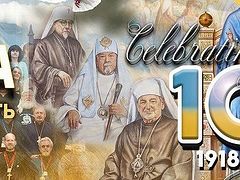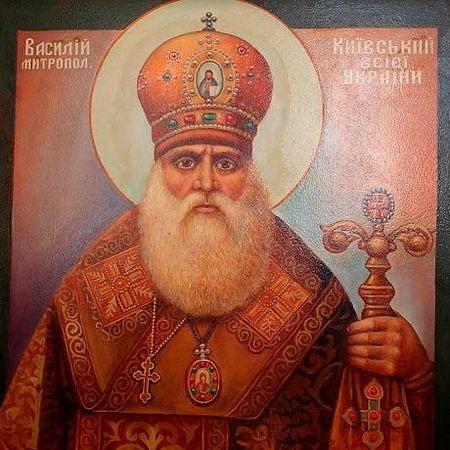 Icon of “Metropolitan” Vasily Lipkovsky, founder of and canonized by the UAOC
Icon of “Metropolitan” Vasily Lipkovsky, founder of and canonized by the UAOC
“Lipkovskyism—that is, ecclesiastical anarchy, ecclesiastical revolutionism—deeply seized the Ukrainian masses, especially the socialist intelligentsia, and it seized our clergy. And although there is virtually nothing and no one left of Lipkovsky in the Church outwardly, it hovers over our Church as a black raven, corrupting it from the inside to this day… And this Lipkovskyism strongly struck at the purity of Ukrainian Orthodoxy and deprived our Church of its glory,” warned the former Archbishop of Kholm and Podlasie and later First Hierarch of the Ukrainian Greek Catholic Church in Canada Metroplitan Hilarion (Prof. I. Ogienko) in 1950.1
This topic, seemingly from the distant past, has been very relevant for modern Ukrainian Orthodoxy for more than ninety years already. Moreover, it is more relevant than it might seem at first glance… It acquires a new special significance in the context of the latest decisions of the Patriarchate of Constantinople about granting a tomos of autocephaly in Ukraine.2
Monuments and icons to an unholy “saint”
Recently, news spread in the Ukrainian media that the Cherkassy Diocese of the UOC-KP is planning to erect a monument to the first metropolitan of the “Ukrainian Autocephalous Orthodox Church” (UAOC) Vasily Lipkovsky on the occasion of the expected tomos of autocephaly.
The curator of the project is Metropolitan John (Yaremenko) of the Cherkassy and Chigirin Diocese of the UOC-KP, who, together with the head of the Cherkassy Province administration Y. Tkachenko, held a special onsite meeting on September 4, 2018 and outlined the site for erecting the monument.
Describing this event in a publication on September 7, 2018, the official site of the UOC-KP calls Vasily Lipkovsky the “ideological inspirer of the independent Ukrainian church,” who “laid the foundation and began this process of the autocephalization of Ukrainian Orthodoxy which now, 100 years after its beginning, is approaching its logical conclusion.” As the UOC-KP site writes, the installing of the monument to Lipkovsky “will be a significant event not only of regional but of a pan-Ukrainian significance, and will forever imprint this outstanding and remarkable personality in the hearts and souls of modern Ukrainians.” And then, tying these plans to the expected tomos from Constantinople, the UOC-KP site notes: “After all, the vast majority of the Ukrainian people are now expecting the granting of autocephaly by Constantinople to one Local Ukrainian Orthodox Church, which will finally make the Ukrainian Church a full member of the global family of Local Orthodox Churches.”3
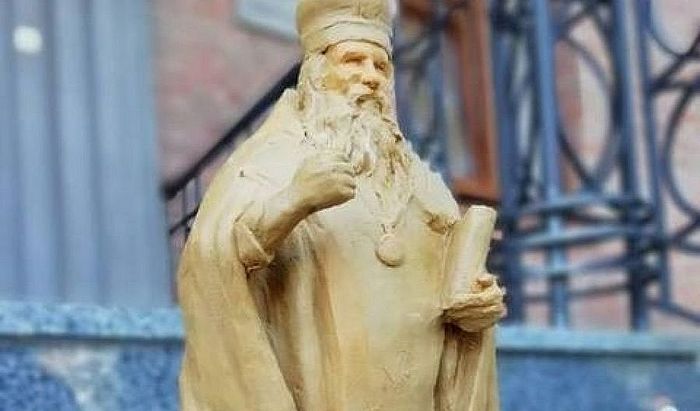 Mockup of the memorial to “Metropolitan” Lipkovsky in Cherkassy, September 2018
Mockup of the memorial to “Metropolitan” Lipkovsky in Cherkassy, September 2018
In his epistles, the primate of the UOC-KP Philaret Denisenko has repeatedly called Vasily Lipkovsky a “metropolitan” and a “great hierarch of Ukraine,” “who took the archpastoral omophorion upon his shoulders” and bore the “hierarchical cross,” and “Metropolitan Vasily Lipkovsky’s example inspires us.”4
The UOC-KP has held many theological conferences and academic jubilees dedicated to Vasily Lipkovsky and his legacy, has served panikhidas and litias for him as for a canonical metropolitan-martyr, and so on.5
The UAOC went even further, canonizing Lipkovsky and other hierarchs of the UAOC appointed by him in 1920s as “Holy New Martyrs of the Ukrainian land” by resolution of the Third Local Council of the UAOC on May 27-28, 1997, and officially entered them into the UAOC’s menaion on November 14.6 In the UAOC, a service was introduced specifically for the “Holy New Martyrs of the Ukrainian land” to “Hieromartyr” Vasily Lipkovsky and other fallen hierarchs of the UAOC in the 1920s, icons were painted, they are venerated as “Orthodox saints,” and they serve molebens and akathists, and so on to them.
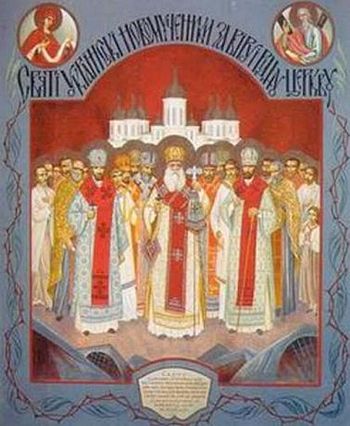 Icon of “Metropolitan” Vasily Lipkovsky and other self-consecrated hierarchs, canonized by the UAOC in 1997
Icon of “Metropolitan” Vasily Lipkovsky and other self-consecrated hierarchs, canonized by the UAOC in 1997
According to the UOC-KP primate, Metropolitan Vasily Lipkovsky is the “inspirer” and “founder” of the autocephaly of Ukrainian Orthodoxy.
We will try here to briefly examine what was actually created in 1921. Could Vasily Lipkovsky be recognized in world Orthodoxy as the canonical founder of Church life, an Orthodox metropolitan, and a saint?
Archpriest Vasily Lipkovsky and the proclamation of the UAOC in 1921
It must be acknowledged that the figure of Vasily Lipkovsky is truly unique and to some extent brilliant. However, in his views and activities, he is reminiscent more of a representative of the Protestant-reformist movement than of an Orthodox hierarch. Being a simple white (married) priest, he tried to lead the Ukrainian autocephaly movement in the 1920s and led it on the path of reformation, fully diving into a deep canonical crisis.
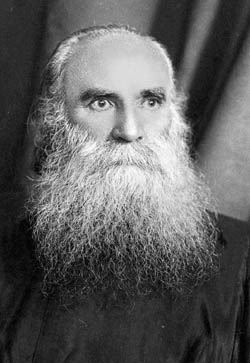 Archpriest Vasily Lipkovksy, the founder of the UAOC formation in 1921 In 1921, with a group of supporters, Archpriest Vasily Lipkovsky, having secured agreement and support from the soviet authorities and having received from it the use of St. Sophia’s Cathedral and a number of other churches in Kiev, announced the creation of the Ukrainian Autocephalous Orthodox Church (we will use the abbreviation UAOC-L, after the name of its founder, to distinguish it from other strains of the UAOC). However, the way in which it was done contradicted all canonical norms and order of universal Orthodoxy. Moreover, they rejected the canons of the Seven Ecumenical Councils and adopted their own new so-called “Kievan canons.” They also introduced a married episcopate that had no apostolic succession and originated from presbyterial self-consecrations from ordinary priests.
Archpriest Vasily Lipkovksy, the founder of the UAOC formation in 1921 In 1921, with a group of supporters, Archpriest Vasily Lipkovsky, having secured agreement and support from the soviet authorities and having received from it the use of St. Sophia’s Cathedral and a number of other churches in Kiev, announced the creation of the Ukrainian Autocephalous Orthodox Church (we will use the abbreviation UAOC-L, after the name of its founder, to distinguish it from other strains of the UAOC). However, the way in which it was done contradicted all canonical norms and order of universal Orthodoxy. Moreover, they rejected the canons of the Seven Ecumenical Councils and adopted their own new so-called “Kievan canons.” They also introduced a married episcopate that had no apostolic succession and originated from presbyterial self-consecrations from ordinary priests.
Thus, Metropolitan Hilarion (Prof. I. Ogienko) quite harshly remarked that “In the atmosphere of socialism arose the UAOC—the Ukrainian Autocephalous Orthodox Church. This Church decisively broke with the age-old tradition of the Kievan Church and the age-old Ukrainian tradition of the purity of Orthodoxy. An unprecedented new formation, it decisively broke with the very soul of Orthodoxy—with the canons of the Seven Ecumenical Councils and created its own ‘canons.’ Our age-old Church ideology was brutally trampled upon. Illiterate loudmouths and demagogues called it ‘the revival of the Ukrainian Church,’ while it was a complete break with the traditional age-old Church of the Ukrainian people, inasmuch as a rebirth is a restoration of what was, but what was created in 1921 never existed in the Ukrainian Church throughout all the centuries of its history.”7
The organizational formation of the UAOC-L occurred at its first All-Ukrainian council in October 1921. It was convened without observing the canonical procedure and without the participation of Orthodox bishops. It was initiated by the so-called “All-Ukrainian Orthodox Church Council” (AOCC)—a public organization including a small group of like-minded priests and laity. Its chairman was the convinced socialist Mikhail Moroz. Among its leading figures, the main role was occupied by the priest of leftist-views Archpriest Vasily Lipkovsky. By the initiative of the AOCC, the Ukrainian Union of Orthodox Parishes (UUOP) was created and registered in soviet Ukraine, on the basis of which was to be held the council.
Initially, this event was planned as the “First All-Ukrainian Church Congress of the Ukrainian Union of Orthodox Parishes,” but during planning it was renamed the “All-Ukrainian Orthodox Church Council,” although many of its delegates had a mandate not for a council but for a congress.8 Even at the meetings themselves, part of the delegates did not agree with renaming the “congress” into a “council” since there wasn’t a single bishop there. However, such dissenters were deprived of the right to vote and participate.
Presbyterial ordinations of Lipkovsky and other bishops of the UAOC
At the time of the opening of the “All-Ukrainian Council” on October 14, 1921, 472 delegates were registered for it, among whom were sixty-four priests, seventeen deacons, and the rest laymen (mainly peasants and workers).9 Note the rather low number of clerical participants. According to the statistics, in 1914, there were 10,565 priests, 1,825 deacons, and 10,793 church chanters10 in Prydniprovksa Ukraine alone (without the Western and Transcarpathian provinces of Ukraine). That is, sixty-four priests and seventeen deacons couldn’t represent the interests and opinions of all the Orthodox clergy of Ukraine. Additionally, they didn’t have authority from their dioceses and participated in the council on their own initiative.
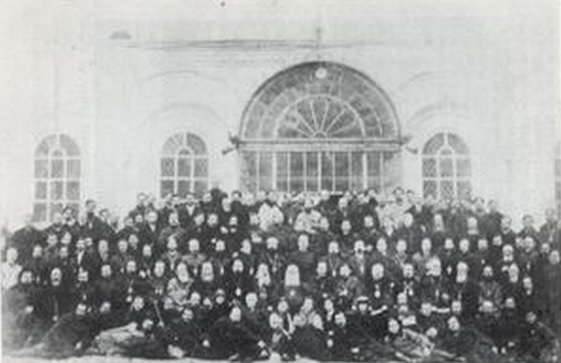 Delegates of the first All-Ukrainian Council of the UAOC-L in front of St. Sophia Cathedral in Kiev, October 1921
Delegates of the first All-Ukrainian Council of the UAOC-L in front of St. Sophia Cathedral in Kiev, October 1921
The most important decisions of the council were the proclamation of the UAOC and the presbyterial consecrations (without bishops) of its first bishops.
Here is how one of the witnesses and participants described this event in the pages of the UAOC-L’s official publication “Church and Life” in 1927:
“The majestic moment of consecration had arrived. The whole community of Christ, the whole council united into a single flame of prayer to the Heavenly Father—to grant, to send the Holy Spirit to the first Ukrainian bishop. The oldest archpriest read the prayer of consecration and all the council members placed their hands on one another’s shoulders, and those standing on the solee, on the shoulders of the deacons, and they on the shoulders of the priests, and the priests on the ordinands. During the Church singing and prayers they dressed those consecrated in hierarchical vestments, and there came a moment of pure, holy joy.”11
As we see, the described ceremony with the invocation “to send the Holy Spirit,” which was named “sobornopravny” or “counciliar right” ordination, and in which laity (men and women) participated through the laying on of hands on one another, is more reminiscent of the rituals of individual charismatic Protestant denominations and the Khlysts.12
From the transcripts of the first UAOC-L council it is clear that there was a schism among its delegates due to the controversies surrounding the bishopless self-consecrations and other reforms.
Already during the council’s work, as one of the participants—the delegate from the Poltava Brotherhood Fr. Dimitry Khrapko—stated, “Two streams have emerged: One purely Orthodox and the other clearly Protestant-sectarian.”13 To his call to strictly adhere to the canons, Fr. Lipkovsky only retorted: “Don’t be slaves to this theology.”14 For several days, the council simmered with lively debates and discussions about the need to observe the Apostolic rules and canons on the issue of establishing new bishops for the Ukrainian Church. However, the supporters of the traditional canonical position were stigmatized with labels like “traitors” and were essentially removed from participating in the work.
The socialists M. Moroz and V. Chekhovsky, who led the council, insisted that the new Ukrainian Church, responding to the challenges of the revolutionary era, must decisively break with the old upper class regime hierarchical customs and create a “new, truly national and conciliar-rule hierarchy,” that would come not from the overlord bishops, but from the common working people. In support of this position, the head of the Brotherhood of Workers of the Word, V. Chekhovsky, relying on Protestant interpretations, developed a theory that the grace of the Holy Spirit is not in the bishops, but in the Church, that is, in the community of believers, and therefore it can lay its hands on the candidate and give him the grace and gifts of the Holy Spirit.15 He also believed that members of the council could, “Ignite the grace of the Holy Spirit by their faith.”16 However, he was relying on the hypothesis that in the ancient Alexandrian and Roman Churches before the First Ecumenical Council, new bishops were ordained by priests without the participation of bishops, and that at the First and later Ecumenical Councils, the bishops distorted this early Christian practice, usurping power in the Church. It’s worth noting here that many studies show that such an interpretation is too simplified and erroneous. In the Alexandrian (African) Church in antiquity there truly did exist a local tradition of the participation of priests in consecrating bishops. However, it was an additional ceremony that didn’t cancel or replace the laying on of hands on a hierarch by bishops, as is required by the first Apostolic Canon (“Let a bishop be ordained by two or three bishops”). By Chekhovsky’s logic, you can take inspiration from any heresy or mistaken practice that arose in the ancient Church and declare it the basis of dogma and Church Tradition. But that’s why the Ecumenical Councils were convened—to normalize and establish common rules and canons for the entire universal Church and to overcome disputes and heresies (in particular, Gnosticism, Arianism, Nestorianism, etc.) that corrupted the early Christian Church from the inside.
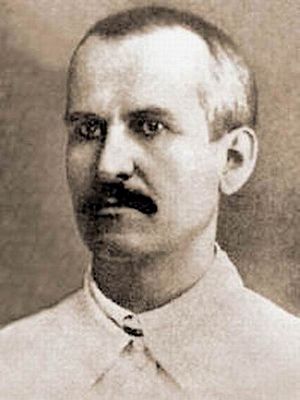 Idealogue and “evangelist” of the UAOC-L, the head of the Brotherhood of the Workers of the Word, Vladimir Chekhovsky Subsequently, on the basis of his report at the council, Chekhovsky wrote a separate work entitled The Foundation of the Liberation of the Church from the Prince of This Age, where he further justified the ideas of presbyterial consecrations and the rejection of the ecclesiastical canons of the Seven Ecumenical Councils.
Idealogue and “evangelist” of the UAOC-L, the head of the Brotherhood of the Workers of the Word, Vladimir Chekhovsky Subsequently, on the basis of his report at the council, Chekhovsky wrote a separate work entitled The Foundation of the Liberation of the Church from the Prince of This Age, where he further justified the ideas of presbyterial consecrations and the rejection of the ecclesiastical canons of the Seven Ecumenical Councils.
In fact, Chekhovsky was manipulating the facts. Fr. Xenophont Sokolovsky17 and many other priests who had a theological education spoke out against his argumentation at the council. However, their protests to the presidium of the council headed by Moroz and Lipkovsky were not taken into account, and several of them were even deprived of the right to vote.
By Lipkovsky’s own acknowledgement, the vast majority of participants in the council were illiterate peasants and workers. Of course, they did not have the relevant theological knowledge and the ability to verify the authenticity of what was said by the leaders of the assembly. As the participant in these events and later chairman of the AOCC of the UAOC (1924-1926) Protodeacon Vasily Poitenko recalled about this: “I won’t hide it: The council deputies were mainly people with little familiarity with Church canons and various shrewd missionary maxims.” On the question of consecrating bishops without the participation of any bishops, as Potienko recalled: “The authorities, which they (the participants in the council) trust, say it can be done. Well, great! A weight’s been lifted from my shoulders… This act would still have taken place: That’s how circumstances turned out. It wouldn’t have happened only if none of the authorities had come up with such an idea.”18
The authority Potienko is referring to is Fr. Vasily Lipkovsky. He fully supported the revolutionary calls of his close colleague and adviser Chekhovsky “to liberate the Church from the upper class regime episcopal-autocratic yoke,” and later in his official letters, having become “metropolitan,” he proudly called himself a “Church revolutionary.”
Archpriest V. Lipkovsky: “Orthodox metropolitan” or “Church revolutionary”
After Vasily Lipkovsky’s presbyterial consecration as bishop and metropolitan, he wrote about himself in his first epistle on October 23, 1921 that he was “a servant of the Lord Jesus Christ, elected by the All-Ukrainian Orthodox Church Council and the grace of the Holy Spirit, established through the laying on of hands of Ukrainian priests and the entire council.”19 In addition to the legal title of “UAOC,” the newly-formed structure was called the “Free National-Conciliar Rule Autocephalous Orthodox Ukrainian Living Church”20 in its official address.
According to all criteria of Orthodox Patristic theological teachings and the canons of the Seven Ecumenical Councils, Fr. Vasily’s views and teachings had the character of an ecclesiological heresy. Under the external national ritual form of Orthodoxy, he preached partially typical Protestant views on the Church and faith mixed with the socialist-revolutionary ideas and slogans of the time. Fr. Lipkovsky considered himself practically an “apostle” and “Ukrainian Luther” who was called to liberate the Ukrainian Church from the “shackles of the past” and the “episcopal-autocratic yoke.”
The rejection of the traditional canonical episcopate was not just an accidental or forced action, as some try to present it. An analysis of the many documents of these events gives reason to believe that it was a conscious and purposeful step. The message of Lipkovsky and the All-Ukrainian Church Council of the UAOC to the Ukrainian people in December 1921 notes:
You are fearful about breaking the old canons. Open your eyes and understand that with the general destruction of everything old, those old cramped houses of the past of Church life must disintegrate and new, more spacious ones must be built… Therefore, the eternally Living Church of Christ should be an eternally creative Church, to arrange its life in accordance with the general conditions of the time… Throw off the yoke of slavish subordination to episcopal autocracy in the Church… There is now before you an infinitely more and only worthy path of the ministry of a servant of God—to be the first servant of His people’s Living Church. Stand on this path… You are very concerned about the formation by the UOC of its own episcopate, untraditional for the time of episcopal autocracy, but a first-apostolic, conciliar-ecclesiastical system. But understand that in this event there is no violation of the Orthodox faith, no destruction of the dogmas of the Orthodox Church by the AOCC. It only accepted the worthiest and most appropriate means of formation worthy of both the Ukrainian Church and the spirit of the faith of Christ by the strength of its own faith and hope in the highest organs for the restoration of our Church life… Are you afraid that the universal Church won’t recognize our event? The universal Church, built on the foundation of the Orthodox faith, but, according to the new demands of life, the living Church, the Church of the future, will certainly recognize this event as the consequence of a living life. And the universal Church of the past, the Church of ruins—where is it? Don’t fear those anathemas that the leaders and supporters of the old Church-tombs, heap upon us.21
And here is another very eloquent document that vividly illustrates the view of Fr. Lipkovsky and the entire UAOC-L. In his declaration of August 15, 1927, sent to the Central Government of the USSR, Lipkovsky wrote the following:
I am a Church revolutionary, because the Ukrainian Church has emerged and is being liberated and the struggle with the old system leads to a revolution, and any reaction in itself will not allow a return. And therefore, the political and social revolution, general liberation, and a more just satisfaction of workers—I welcome. I have been interested only in Church matters my entire life, dreaming of the liberation of the Church, that is, of its state when there will be no nobility, no principality, but only brotherhood, and when the state will not interfere in its life. And I am happy to have lived to see the possibility of realizing this state of the Church during the time of the Soviet regime, by its laws on the separation of church and state. I never reconciled with the state of the Church under the capitalist system and Russian tsarism, when it was burdened with limitless treasures for many centuries, started serving mammon, and thereby lost Christ’s covenants and extinguished the spirit of Christ within itself, according to the word of Christ: Ye cannot serve God and mammon (Mt. 6:24), and gave itself over to the service of the state for this mammon; I am happy that under the Soviet authorities, the Church is liberated from the burden of capitalism, returning to the state of Christ… All the feelings of supreme happiness in my life that I have experienced thanks to the Soviet authorities make me a sincere supporter of the Soviet authorities, make me desire its development and strengthening… According to the will of the apostle, I obey the Soviet authorities in everything, as its conscious citizen I have and will fulfill its laws, and I give it due respect not only for fear, but also for conscience, and the Soviet authorities will never see in me an opponent or a rebel against it. I testify to this for the entire Ukrainian Church… I confess and preach that the Church of Christ is above parties, does not know parties, and the Ukrainian Church is actually the Church of the worker and the peasant, and therefore the happy conscious life of workers and peasants is much closer to it, and any oppression or exploitation of workers and peasants is much more opposed to it… These are my frankly, truthfully, and sincerely expressed spiritual moods and beliefs by which I live and on the basis of which I work.22
This declaration of Vasily Lipkovsky for 1927 is his own peculiar “symbol of faith,” which reveals his ecclesiological views and teachings about the Church and the socialist revolution.
The “Kievan Canons” of the UAOC-L
As can be seen from the cited documents, the council of the UAOC-L, consciously going down the path of revolutionary reformation, in fact rejected the canons of the Seven Ecumenical Councils as “obsolete.” Their own so-called “Kievan canons” of the UAOC-L were adopted at it.
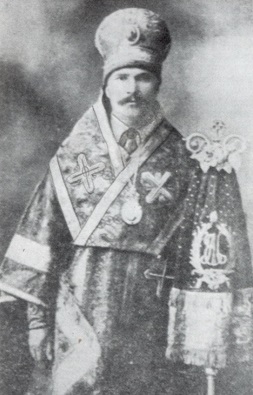 The third First Hierarch of the UAOC-L, “Metropolitan” Ivan Pavlovsky, 1930s In particular, in the first paragraph of these “canons” it was noted that the “episcopal-autocratic system of the Church, developed under the influence of the conditions of the historical and state-monarchic systems of those times, which were filled with old canons, in the future cannot remain and should be changed by the Church-conciliar rule structure.” Among other things, the new “canons” proclaimed (§ 2, PP. 12) that the UAOC “manages its own Church life under the direction of the Holy Spirit.”23
The third First Hierarch of the UAOC-L, “Metropolitan” Ivan Pavlovsky, 1930s In particular, in the first paragraph of these “canons” it was noted that the “episcopal-autocratic system of the Church, developed under the influence of the conditions of the historical and state-monarchic systems of those times, which were filled with old canons, in the future cannot remain and should be changed by the Church-conciliar rule structure.” Among other things, the new “canons” proclaimed (§ 2, PP. 12) that the UAOC “manages its own Church life under the direction of the Holy Spirit.”23
The presbyterial self-consecrated so-called “conciliar-rule” consecrations of bishops (§ 4, p. 6) were approved as “canonical” by the “canons” of the UAOC-L; a married episcopate was introduced (§ 11, p. 2, 16); all authority passed to the Church councils (rule councils, called “conciliar-rule”), but the majority of the functions of the episcopate were transferred to the laity (§§ 1, 3 и 4); the right of priests to repeatedly divorce and marry again was introduced, and this right itself was to be regulated only by the norms of the civil soviet legislation (§ 11, p. 2, 16-18); the “old Greek monastic charter” was abolished (§ 9, p. 3), and monasteries were turned into religious-labor communes and were to enter as individual brotherhoods into the makeup of parishes (§ 9, p. 1-2); it was allowed to make changes to the Divine services by introducing “new works, as inspired expressions of a living Church-religious creativity” (§ 10, p. 2), and other administrative and ecclesiastical-canonical reforms were implemented.24
The UAOC-L council also approved an appeal to all the Local Orthodox Churches of the world with a call to follow their example, carry out similar reforms, and together convene the Eighth Ecumenical Council in Kiev, to approve the above-mentioned Church reforms.25
Opposition to radical reform trends and the schism of the Ukrainian autocephalous movement
Because of the domination of radical reformist sentiments at the 1921 Kiev council, part of the traditionalist-minded participants not only did not support them, but stopped participating in it. The council transcripts have preserved many names of priests and lay delegations who not only discussed, but categorically protested against the proposals of the presbyterial self-consecrated consecrations and other reformist tendencies. The leadership of the council even deprived several active opposition-traditionalists of the right to speak and vote. As a result, only 258 of the 472 delegates voted for self-consecrations. A little less than half—214 delegates—either didn’t vote or left the meeting.26 Moreover, of the sixty-four priests and seventeen deacons present at the council, only thirty priests and twelve deacons agreed to take part in the self-ordination of Vasily Lipkovsky.27 That is, more than half of the priests (thirty-four out of sixty-four) refused to participate in this, in their opinion, non-canonical action, for various reasons.
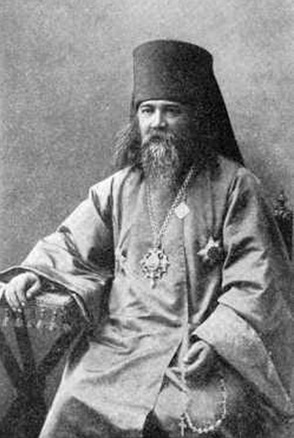 Archbishop Partheny (Levitsky) of Poltava It is emblematic that supporters of the Ukrainian autocephaly movement like Bishop Agapit (Vishnevsky), Bishop Anthony (Granovsky), and Archbishop Partheny (Levitsky) categorically refused to recognize the decisions of the October Kiev council of the UAOC-L. The latter, occupying the See of Poltava, was a spiritual leader of the Ukrainian Church movement in the Poltava Province and was considered the ideological inspirer of the rebirth of the Ukrainian Church. And if in 1920 he had agreed to grant canonical shelter to Fr. Lipkovsky and his supporters under his omophorion, and even gave preliminary consent to be the primate of the Ukrainian autocephalous Church, then by 1921, having become better acquainted with the socialist-protestant radical reformist ideas of this trend, he began to disown them in every way. He therefore did not recognize Lipkovsky’s newly-formed UAOC-L. His reasons were purely ideological, canonical, and ecclesiological. A consistent Ukrainophile, he remained at the same time a consistent conservative and traditionalist in ecclesiastical-canonical issues. His closest disciple and helper, Fr. Theophil Buldovsky, also did not recognize the UAOC-L and a year and a half later (in January 1923) received a canonical consecration as the bishop of Lubny and Mirgorod, and in 1925 took part in the creation of an alternative to the “Lipkovskyite” so-called “conciliar-episcopal” UAOC (the so-called “Lubny Synod” or UAOC-B—of Buldovsky). At first, it was headed by one of the old leaders of the Ukrainian autocephaly movement Priest Pavel Pogorilko, who was one of the first candidates for the episcopacy nominated by the AOCC of the UAOC. Not recognizing the self-ordinations, in January 1923 he received an episcopal consecration from the former canonical Bishop Anthony (Granovsky). The former canonical bishops Ioanniky (Sokolovsky) of Ekaterinoslav, Sergei (Labuntsov) of Prilutsk, and Sergei (Ivanitsky) of Snovsk also joined this branch. From 1926, this “conciliar-episcopal” UAOC-B was finally headed by the aforementioned Theophil (Buldosky) as its metropolitan, which subsequently, in 1942, merged with the UAOC-P of Metropolitan Polycarp (Sikorsky).
Archbishop Partheny (Levitsky) of Poltava It is emblematic that supporters of the Ukrainian autocephaly movement like Bishop Agapit (Vishnevsky), Bishop Anthony (Granovsky), and Archbishop Partheny (Levitsky) categorically refused to recognize the decisions of the October Kiev council of the UAOC-L. The latter, occupying the See of Poltava, was a spiritual leader of the Ukrainian Church movement in the Poltava Province and was considered the ideological inspirer of the rebirth of the Ukrainian Church. And if in 1920 he had agreed to grant canonical shelter to Fr. Lipkovsky and his supporters under his omophorion, and even gave preliminary consent to be the primate of the Ukrainian autocephalous Church, then by 1921, having become better acquainted with the socialist-protestant radical reformist ideas of this trend, he began to disown them in every way. He therefore did not recognize Lipkovsky’s newly-formed UAOC-L. His reasons were purely ideological, canonical, and ecclesiological. A consistent Ukrainophile, he remained at the same time a consistent conservative and traditionalist in ecclesiastical-canonical issues. His closest disciple and helper, Fr. Theophil Buldovsky, also did not recognize the UAOC-L and a year and a half later (in January 1923) received a canonical consecration as the bishop of Lubny and Mirgorod, and in 1925 took part in the creation of an alternative to the “Lipkovskyite” so-called “conciliar-episcopal” UAOC (the so-called “Lubny Synod” or UAOC-B—of Buldovsky). At first, it was headed by one of the old leaders of the Ukrainian autocephaly movement Priest Pavel Pogorilko, who was one of the first candidates for the episcopacy nominated by the AOCC of the UAOC. Not recognizing the self-ordinations, in January 1923 he received an episcopal consecration from the former canonical Bishop Anthony (Granovsky). The former canonical bishops Ioanniky (Sokolovsky) of Ekaterinoslav, Sergei (Labuntsov) of Prilutsk, and Sergei (Ivanitsky) of Snovsk also joined this branch. From 1926, this “conciliar-episcopal” UAOC-B was finally headed by the aforementioned Theophil (Buldosky) as its metropolitan, which subsequently, in 1942, merged with the UAOC-P of Metropolitan Polycarp (Sikorsky).
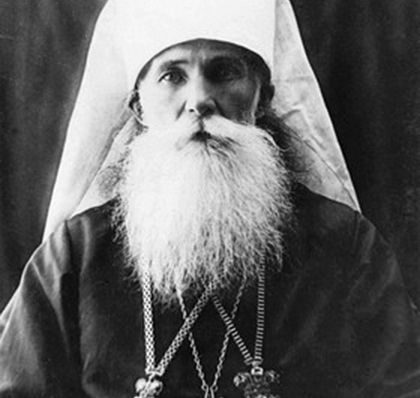 The First Hierarch of the “conciliar-episcopal” UAOC-B, Metropolitan Theophil Buldovsky
The First Hierarch of the “conciliar-episcopal” UAOC-B, Metropolitan Theophil Buldovsky
The emergence of the “conciliar-episcopal” UAOC-B was a kind of alternative response of the Ukrainian autocephalists-traditionalists to the emergence of the reformist-self-consecrated UAOC-L. Moreover, the UAOC-B was then joined by several figures of the Ukrainian autocephalous movement who took an active part in it from 1917-1918 but did not agree with the non-canonical decisions of the Kiev Council of 1921. At the same time, from 1925, the so-called “synodal” or “renovationist” “Ukrainian Orthodox Autocephalous Church” (UOAC) appeared in Ukraine, headed by the former Archbishop of Podolsky Pimen (Pegov). The Secretary of the UOAC Synod, Archbishop Seraphim (Lyade) was subsequently received into the Russian Orthodox Church Abroad (ROCA) in his existing rank, where he became a metropolitan and head of the Central European Metropolitan District of the ROCA.
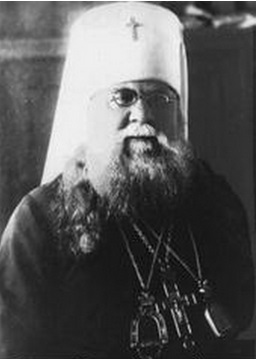 First Hierarch of the “synodal-renovationist” UOAC, Metropolitan Pimen Pegov All three of these Ukrainian ecclesiastical currents (the UAOC-L, the UAOC-B, and the UOAC) were, one way or another, “ideological inspirers of the independent Ukrainian church,” having begun the movement for autocephaly. At first, they were all actively supported by the soviet government, which was interested in the schism in Orthodoxy in Ukraine and the weakening of the position of the “Tikhonite” Patriarchal Church. However, by the 1930s, they were all subjected to repressions from the communist regime and were destroyed.
First Hierarch of the “synodal-renovationist” UOAC, Metropolitan Pimen Pegov All three of these Ukrainian ecclesiastical currents (the UAOC-L, the UAOC-B, and the UOAC) were, one way or another, “ideological inspirers of the independent Ukrainian church,” having begun the movement for autocephaly. At first, they were all actively supported by the soviet government, which was interested in the schism in Orthodoxy in Ukraine and the weakening of the position of the “Tikhonite” Patriarchal Church. However, by the 1930s, they were all subjected to repressions from the communist regime and were destroyed.
The appearance of the UAOC-B and UOAC in Ukraine was a certain reaction to the non-canonical emergence of the “Lipkovsky” UAOC.
In fact, under the externally ceremonial appearance of the Orthodox Church, a Christian denomination was created in 1921 that partly resembled a Protestant denomination rather than Orthodoxy. For this reason, it wasn’t recognized by any Church in the world and was considered self-consecrated and heretical, provoking new schisms in Ukrainian Orthodoxy.
Lipkovskyism as an obstacle to the unification of the Ukrainian Church
In the Canadian journal “Word of Truth” edited by him, the aforementioned Metropolitan Hilarion (Ogienko), reflecting upon the obstacles to the unification and recognition of the Ukrainian Churches, noted that one of the serious problems here was precisely the legacy of the “Lipkovskyites,” born in Ukraine in 1921 under the influence of Bolshevik revolutionary sentiments. In his opinion, this heritage, like a virus, had been corroding and destroying the Ukrainian Church from within for decades. “Faith without the acceptance of the holy canons of the Seven Ecumenical Councils is Protestantism. Because the universal Church did not recognize the Kievan UOAC of 1921, it also views the new UAOC with suspicion as not Orthodox, because it traces its origins back to Lykovskyism. This is one of the main obstacles to the recognition and unification of our Churches… And although outwardly, practically nothing and no one remained of the Lipkovsky Church, a black raven hovers over our Church and corrupts it from the inside to this day,” wrote Met. Hilarion.28
More than sixty years have passed since these words of Hilarion (Ogienko), but his words have remained relevant to this day. Unfortunately, even in the twenty-first century, the spiritually distorted and heretical ecclesiology and legacy of Lipkovskyism has not been overcome in the Ukrainian Churches (both the UAOC and the UOC-KP). Although they no longer have continuity in the ordinations from the self-consecrated Lipkovsky hierarchy, this Lipkovsky legacy on the ecclesiological and spiritual-ideological level is still considered the basis for the emergence of the autocephaly of the Ukrainian Church, worthy of praise, imitation, and veneration. This is evident from many publications of both the UAOC and the UOC-KP.
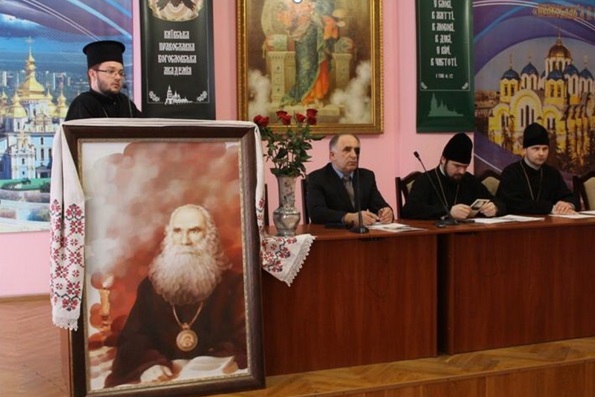 Conference at the theological academy of the UOC-KP, dedicated to the memory and heritage of Lipkovsky, March 19, 2014
Conference at the theological academy of the UOC-KP, dedicated to the memory and heritage of Lipkovsky, March 19, 2014
Thus, on October 22, 2001, at the Kiev Theological Academy of the UOC-KP, with the blessing of “Patriarch Philaret,” there was a solemn academic-theological conference in honor of the eightieth anniversary of the “Kiev Council” of 1921. Representatives from the UAOC also took part in these events, also actively celebrating this anniversary. In the final resolution of the theological conference in the walls of the UOC-KP academy, it was unanimously declared that:
The All-Ukrainian Council of 1921 is the most important milestone of Ukrainian Church history in the twentieth century. It is equally important for both the UAOC and the UOC-KP… The 1921 council reflected the common Orthodox problems of union of faithfulness to the traditions and the ability to renew, which are still the fundamental problems of the Church… The council of 1921 was full of the holy flame of faith. And its radicalism reminds of the words of the Savior.29
From this resolution it is clear that both the UAOC and the UOC-KP to this day continue to derive their ideological-historical origins from Lipkovsky and the self-consecrated UOAC formation of 1921. Moreover, the Synod of the UOC-KP accepted the so-called “UAOC-Conciliar-Rule” in the U.S. with its hierarchs and clerics in their existing orders, who officially confess the so-called “Kievan canons” of 1921 and consider Lipkovsky’s legacy the foundation of modern Ukrainian Church life.
Thus, with the adoption of the hierarchs of the UAOC and UOC-KP into ecclesiastical communion by the Patriarchate of Constantinople, the problem of the Lipkovskyites is now the canonical problem of the Church of Constantinople.
Can the Patriarchate of Constantinople solve this problem, and how? So far, there are no orders or qualifications from it on the Church level as such about the inadmissibility of the popularization and veneration of the Lipkovskyite heritage, that it does not correspond to the traditions, canons, and teachings of the universal Orthodox Church. It’s not surprising, given that they don’t know all the details of internal Ukrainian Church life.
Meanwhile, the UOC-KP is preparing to erect a monument to Vasily Lipkovsky on the occasion of receiving a tomos of autocephaly from Constantinople.30 And the UAOC emphasizes that the latest decisions of the Synod of the Patriarchate of Constantinople are, among other things, a recognition of the 1921 UAOC and the “saint” it canonized, Vasily Lipkovsky.31
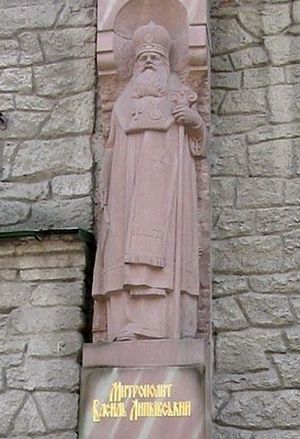 Monument to Lipkovsky at the walls of the UAOC cathedral in Ternopil The problem acquires particular relevance because as Lipkovskyism wasn’t officially condemned at the conciliar level by either the UAOC or the UOC-KP, then after the unification council, the question of automatically recognizing both the Lipkovsky heritage and the canonization of its “saints,” Lipkovsky and other self-consecrated hierarchs, which occurred in the UAOC in 1997, will arise.32
Monument to Lipkovsky at the walls of the UAOC cathedral in Ternopil The problem acquires particular relevance because as Lipkovskyism wasn’t officially condemned at the conciliar level by either the UAOC or the UOC-KP, then after the unification council, the question of automatically recognizing both the Lipkovsky heritage and the canonization of its “saints,” Lipkovsky and other self-consecrated hierarchs, which occurred in the UAOC in 1997, will arise.32
It is as yet unclear what Constantinople will do with these canonizations. Probably its attempts to limit the right of the newly-created autocephalous Church to independently canonize saints and the requirement to coordinate such actions with the Synod of the Patriarchate of Constantinople are conditioned, among other things, by the fear that the new church will begin to indiscriminately canonize its own non-canonical figures as saints, from Vasily Lipkovsky to the newly-deceased modern hierarchs.
It’s a real problem for the Patriarchate of Constantinople, which is why it seeks to limit the rights to such actions.
However, even without recognizing these canonizations, by receiving the hierarchs and clergy of the UAOC into its jurisdiction without any canonical qualifications, the Patriarchate of Constantinople receives into its ecclesiastical organism both the Lipkovsky heritage and its “saints,” because in the Church, as a mystical organism, through prayer and the Eucharist, all its members are united. And even in the new jurisdiction, when the former bishops and priests of the UAOC continue to prayerfully venerate Lipkovsky as a “locally-venerated saint,” to commemorate him as a “saint” during the Liturgy, to serve molebens and akathists to him, and so on (as is practiced in the UAOC to this day), then it will pertain to the Patriarchate of Constantinople. It will no longer be an inter-Ukrainian problem, but a general canonical Church problem of universal Orthodoxy, which will have to, sooner or later, give a canonical response.
Appendix:
Welcome address of the “Patriarch of Kiev and All Rus’-Ukraine Philaret” on the occasion of the 150th anniversary of the birth of Metropolitan Vasily Lipkovsky, May 14, 201433
The genuine Ukrainian Church teaches love for Ukraine, love for the Ukrainian people, for Ukrainian symbols, for Ukrainian traditions, because it is the Church of the sons and daughters of Ukraine who gave their lives for the happy and free future of future generations.
Among such outstanding personalities of Ukrainian history is the true patriot and pastor of the Ukrainian Church, a Galician by birth, Metropolitan Vasily Lipkovsky. He did not fear wolves in sheep’s clothing, did not fear to bear the heavy hierarchical cross among the trials, ridicule, persecution, slander, and persecutions, but took the archpastoral omophorion upon his shoulders and until his last breath did not abandon his flock, did not resort to emigration. And although the atheist authorities of that time did not give him the opportunity carry out his ministry, he remained in his Ukrainian land, among his people, where he continued to bear the podvig of prayer and the podvig of love.
Welcoming the high academic community that has gathered to honor the memory of this great hierarch of Ukraine, I call God’s blessing upon you all. May the Chief Shepherd the Lord Jesus Christ, through the example of Metropolitan “Vasily Lipkovsky, inspire us to love our land, respect the memory of our ancestors, value the traditions of our people, and not serve foreigners in body in their state, or in soul in their Ukrainian Church. May your labor bring rich fruits for the cultural and academic formation of the young generation of the blessed-of-God Ukraine!
+ Philaret
Patriarch of Kiev and All Rus’-Ukraine
May 14, 2014



